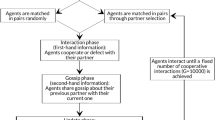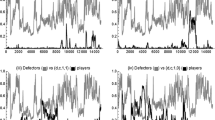Abstract
Can chimpanzees learn the reputation of strangers indirectly by observation? Or are such stable behavioral attributions made exclusively by first-person interactions? To address this question, we let seven chimpanzees observe unfamiliar humans either consistently give (generous donor) or refuse to give (selfish donor) food to a familiar human recipient (Experiments 1 and 2) and a conspecific (Experiment 3). While chimpanzees did not initially prefer to beg for food from the generous donor (Experiment 1), after continued opportunities to observe the same behavioral exchanges, four chimpanzees developed a preference for gesturing to the generous donor (Experiment 2), and transferred this preference to novel unfamiliar donor pairs, significantly preferring to beg from the novel generous donors on the first opportunity to do so. In Experiment 3, four chimpanzees observed novel selfish and generous acts directed toward other chimpanzees by human experimenters. During the first half of testing, three chimpanzees exhibited a preference for the novel generous donor on the first trial. These results demonstrate that chimpanzees can infer the reputation of strangers by eavesdropping on third-party interactions.




Similar content being viewed by others
Notes
In the animal behavior literature, ‘eavesdropping’ has been defined in terms of how individuals use ‘public information’ (Valone 2007). Our use of the term ‘eavesdropping’ in this paper is consistent with the definition of Parejo and Aviles (2007), “the behavior involving the extraction of information from signaling interactions between others” (81).
In the cognitive and computer sciences, a ‘domain’ generally refers to a specific class of information. Fodor (1983), referred to mechanisms that operate on a specific domain as ‘modules.’ These modules are specialized (processing only certain types of information), fast and ‘encapsulated,’ meaning that they operate outside of conscious awareness and are not affected by learning. In contrast, here, we define the ability to make reputation judgments as an abstract social reasoning skill, meaning that judgments of reputation though social, are not limited to specific social contexts or information. Such judgments can thus be used flexibly in novel circumstances and require inferential reasoning; they may even be applied to non-social agents like computers or even vending machines with a bad ‘reputation’ of stealing your money. We do not believe that the claims of ‘reputation” in fish and birds (Amy and Leboucher 2007; Brosnan et al. 2003; Bshary and Grutter 2006; Grosenick et al. 2007; Paz-y-Miño et al. 2004; Rooney and Bradshaw 2006) meet this more stringent criterion.
After all, we, as humans, often have grave difficulty initially discriminating between members of other species, even chimpanzees.
References
Amy M, Leboucher G (2007) Male canaries can visually eavesdrop on conspecific food interactions. Anim Behav 74:57–62
Alexander RD (1987) The biology of moral systems. Aldine de Gruyter, New York
Axelrod R (1984) The evolution of cooperation. Basic Books, New York
Bandura A (1965) Vicarious process: a case of no-trial learning. In: Berkowitz L (ed) Advances in experiment social psychology, vol 2, Academic Press, New York, pp 1–55
Bandura A (1977) Social learning theory. Prentice-Hall, Englewood Cliffs
Boesch C, Boesch-Achermann H (2002) The chimpanzees of the Taï Forest. Oxford University Press, Oxford
Brandt H, Sigmund K (2005) Indirect reciprocity, image scoring, and moral hazard. Proc Natl Acad Sci USA 102:2666–2670
Brandt H, Hauert C, Sigmund K (2003) Punishment and reputation in spatial goods games. Proc R Soc Lond B 270:1099–1104
Brosnan SF, de Waal FBM (2003) Monkeys reject unequal pay. Nature 425:297–299
Brosnan SF, Earley RL, Dugatkin LE (2003) Observational learning and predator inspection in guppies (Poecilia reticulata). Ethology 109:823–833
Brumm H, Kipper S, Riechelmann C Todt D (2005) Do Barbary macaques ‘comment’ on what they see? A first report on vocalizations accompanying interactions of third parties. Primates 46:141–144
Bshary R, Grutter AS (2006) Image scoring and cooperation in a cleaner fish mutualism. Nature 22(7096):975–978
Call J, Tomasello M (1998) Distinguishing intentional from accidental actions in orangutans, chimpanzees, and human children. J Comp Psychol 112:192–206
Call J, Hare B, Carpenter M, Tomasello M (2004) ‘Unwilling’ versus ‘Unable’: chimpanzees understanding of human intentional action. Dev Sci 7:488–498
De Waal FBM (1982) Chimpanzee politics. Harper and Row, New York
Dunbar R (1986) Grooming, gossip, and the evolution of language. Harvard University Press, Boston
Fehr E (2002) Altruistic punishment in humans. Nature 415:137–140
Fehr E, Fischbacher U (2003) The nature of human altruism. Nature 425:785–791
Fodor G (1983) The modularity of mind. MIT Press, Cambridge
Goodall J (1986) The chimpanzees of Gombe. Belknap Press, Cambridge
Grosenick L, Clement TS, Fernald RD (2007) Fish can infer social rank by observation alone. Nature 445:429–432
Hauser MD (1992) Costs of deception: cheaters are punished in rhesus monkeys. Proc Natl Acad Sci USA 89:12137–12139
Hauser MD, Chen MK, Chen F Chuang E (2003) Give unto others: genetically unrelated cotton-top tamarin monkeys preferentially give food to those who altruistically give food back. Proc R Soc Lond B 270:2363–2370
Hirata S, Fuwa K (2007) Chimpanzees (Pan troglodytes) learn to act with other individuals in a cooperative task. Primates 48:13–21
Hohmann G, Gerloff U, Tautz D, Fruth B (1999) Social bonds and genetic ties: kinship, association, and affiliation in a community of bonobos (Pan paniscus). Behaviour 136:1219–1235
Horner V, Whiten A (2005) Causal knowledge and imitation/emulation switching in chimpanzees (Pan troglodytes) and children (Homo sapiens). Anim Cogn 8:164–181
Jensen K, Hare B, Call J, Tomasello M (2006) What’s in it for me? Self-regard precludes altruism and spite in chimpanzees. Proc R Soc Bio Sci 273(1589):1013–1021
Maass A, Colombo A, Colombo A, Sherman SJ (2001) Inferring traits from behaviors versus behaviors from traits: the induction–deduction asymmetry. J Pers Soc Psychol 81:391–404
McGregor PK, Dabelsteen T (1996) Communication networks. In: Kroodsma DE, Miller EH (eds) Ecology and evolution of acoustic communication among birds. Cornell University Press, Ithaca, pp 409–425
Melis AP, Hare B, Tomasello M (2006) Chimpanzees recruit the best collaborators. Science 311:1297–1300
Mitani JC, Watts DP (2001) Why do chimpanzees hunt and share meat? Anim Behav 61:915–924
Mitani J, Merriwether DA, Zhang CB (2000) Male affiliation, cooperation, and kinship in wild chimpanzees. Anim Behav 59:885–893
Mitani JC, Watts DP, Muller MN (2002) Recent developments in the study of wild chimpanzee behavior. Evol Anthropol 11:9–25
Nishida T, Hosaka K (1996) Coalition strategies among adult male chimpanzees of the Mahale Mountains In: McGrew WC, Marchant LF, Nishida T (eds) Great ape societies. Cambridge University Press, Cambridge, pp 114–134
Nowak MA, Sigmund K (1998) Evolution of indirect reciprocity by image scoring. Nature 393:573–577
Parejo D, Aviles JM (2007) Do avian brood parasites eavesdrop on heterospecific sexual signals revealing host quality? A review of the evidence. Anim Cogn 10:81–88
Paz-y-Miño G, Bond AB, Kamil AC, Balda RP (2004) Pinyon jays use transitive inference to predict social dominance. Nature 430:778–781
Perry S, Manson JH (2003) Traditions in monkeys. Evol Anthropol 12:71–81
Povinelli DJ (2003) Folk physics for apes: the chimpanzee’s theory of how the world works. Oxford University Press, Oxford
Povinelli DJ (2004) Behind the ape’s appearance: escaping anthropocentrism in the study of other minds, Daedalus, pp 29–41
Povinelli DJ, Perilloux HK, Reaux JE, Bierschwale DT (1998) Young and juvenile chimpanzees’ (Pan troglodytes) reactions to intentional versus accidental and inadvertent actions. Behav Processes 42:205–218
Rooney NJ, Bradshaw JWS (2006) Social cognition in the domestic dog: behavior of spectators towards participants in interspecific games. Anim Behav 72:343–353
Russon AE, Galdikas BM (1993) Imitation in free-ranging rehabilitant orangutans (Pongo pygmaeus). J Comp Psychol 107:147–161
Seabright P (2005) In the company of strangers. Princeton University Press, Princeton
Sigmund K, Hauert C, Nowak MA (2001) Reward and punishment. Proc Natl Acad Sci USA 98:10757–10762
Silk JB, Brosnan SF, Vonk J, Henrich J, Povinelli DJ, Richardson AS, Lambeth SP, Mascaro J, Schapiro SJ (2005) Chimpanzees are indifferent to the welfare of unrelated group members. Nature 437:1357–1359
Stoinski TS, Wrate JL, Ure N, Whiten AN (2001) Imitative learning by captive western lowland gorillas (Gorilla gorilla gorilla) in a simulated food-processing task. J Comp Psychol 115:272–281
Subiaul F (2007) The imitation faculty in monkeys: evaluating its features, distribution and evolution. J Anthropol Sci 85:35–62
Subiaul F, Cantlon JF, Holloway RL, Terrace HS (2004) Cognitive imitation in rhesus macaques. Science 305:407–410
Subiaul F, Okamoto-Barth S, Barth J, Povinelli DJ (2006) Human cognitive specializations. In: Preuss TM, Kaas JH (eds) Evolution of nervous systems: volume V; the evolution of primate nervous systems. Elsevier, New York
Sugiyama Y (1994) Tool use by wild chimpanzees. Nature 367:327
Tomasello M (1999) The human adaptation for culture. Annu Rev Anthropol 28:509–529
Valone TJ (2007) From eavesdropping on performance to copying the behavior of others: a review of public information use. Behav Ecol Sociobiol 62:1–14
van Schaik CP, Ancrenaz M, Borgen G, Galdikas B, Knott CD, Singleton I, Suzuki A, Utami SS, Merrill M (2003) Orangutan cultures and the evolution of material culture. Science 299:102–105
Visalberghi E, Fragaszy DM, Savage-Rumbaugh S (1995) Performance in a tool-using task by common chimpanzees (Pan troglodytes), bonobos (Pan paniscus), an orangutan (Pongo pygmaeus), and capuchin monkeys (Cebus apella). J Comp Psychol 109:52–60
Voelkl B, Huber L (2007) Imitation as faithful copying of a novel technique in marmoset monkeys. PLoS ONE 2(7):e611
Vonk J, Povinelli DJ (2006) Similarity and difference in the conceptual systems of primates: the unobservability hypothesis. In: Wasserman E, Zentall T (eds) Comparative cognition: experimental explorations of animal intelligence. Oxford University Press, Oxford, pp 363–387
Vonk J, Brosnan SF, Povinelli DJ, Henrich J, Shapiro S, Richardson A, Lambeth SP, Silk JB (2008) Chimpanzees do not take advantage of low-cost opportunities to deliver food to group-mates. Anim Behav (in press)
Warneken F, Tomasello M (2006) Altruistic helping in human infants and young chimpanzees. Science 311:1301–1302
Watts DP (1998) Coalitionary mate guarding by male chimpanzees at Ngogo, Kibale National Park, Uganda. Behav Ecol Sociobiol 44:43–55
Watts DP (2002) Reciprocity and interchange in the social relationships of wild male chimpanzees. Behaviour 139:343–370
Watts DP (2004) Intracommunity coalitionary killing of an adult male chimpanzee at Ngogo, Kibale National Park, Uganda. Inter J Primatol 25:507–521
Watts DP, Mitani J (2001) Boundary patrols and intergroup encounters in wild chimpanzees. Behaviour 138:299–327
Wedekind C, Milinski M (2000) Cooperation through image scoring in humans. Science 288:850–852
Winter L, Uleman JS (1984) When are social judgments made? Evidence for the spontaneousness of trait inferences. J Pers Soc Psychol 47:237–252
Whiten A (1998). Imitation of the sequential structure of actions by chimpanzees (Pan troglodytes). J Comp Psychol 112:270–281
Whiten A, Custance DM, Gomez JC, Teixidor P, Bard KA (1996) Imitative learning of artificial fruit processing in children (Homo sapiens) and chimpanzees (Pan troglodytes). J Comp Psychol 110:3–14
Whiten A, Goodall J, McGrew WC, Nishida T, Reynolds V, Sugiyama Y, Tutin CE, Wrangham RW, Boesch C (1999). Cultures in chimpanzees. Nature 399:682–685
Whiten A, Horner V, Litchfield CA, Marshall-Pescini S (2004) How do apes ape? Learn Behav 32:36–52
Whiten A, Spiteri A, Horner V, Bonnie KE, Lambeth SP, Schapiro SJ, de Waal FB (2007) Transmission of multiple traditions within and between chimpanzee groups. Curr Biol 17:1038–1043
Wrangham R (1999) Evolution of coalitionary killing. Yearb Phys Anthropol 42:1–30
Zentall TR (2006) Imitation: definitions, evidence, and mechanisms. Anim Cogn 9:335–353
Acknowledgments
We would like to thank S. F. Brosnan, F. deWaal, E. Fehr, and D. J. Povinelli, for their comments on earlier versions of this manuscript. We would also like to thank A. Rideaux, L. Loston, T. LaVergne and J. Reaux as well as all the volunteers that served as donors for their assistance throughout this project. This research was supported in part by a Centennial Fellowship from the James S. McDonnell Foundation to DJP and a Research Award from the James S. McDonnell Foundation to H.S. Terrace, J. Metcalfe and F. Subiaul. All studies were reviewed and approved by the Institutional Animal Care and Use Committee of the University of Louisiana, Lafayette.
Author information
Authors and Affiliations
Corresponding author
Rights and permissions
About this article
Cite this article
Subiaul, F., Vonk, J., Okamoto-Barth, S. et al. Do chimpanzees learn reputation by observation? Evidence from direct and indirect experience with generous and selfish strangers. Anim Cogn 11, 611–623 (2008). https://doi.org/10.1007/s10071-008-0151-6
Received:
Revised:
Accepted:
Published:
Issue Date:
DOI: https://doi.org/10.1007/s10071-008-0151-6




